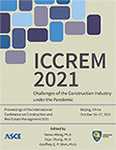Carbon Emissions of Discarding and Demolition Stage for Teaching Building
Publication: ICCREM 2021
ABSTRACT
The building sector is significant consumer of energy and natural resources, as well as significant construction to carbon emissions worldwide. It is expected to have great potential for emission reduction. The life cycle of teaching building generally includes the raw material production stage, construction stage, operation stage, and discarding and demolition stage. However, the current quantitative studies on carbon emissions of teaching building mostly focus on the construction stage and operation stage, and few studies have considered the discarding and demolition stage. To address this issue, this study focuses on the discarding and demolition stage of teaching building and pursues quantitative research. According to the life-cycle assessment (LCA), the discarding and demolition stage is divided into four stages: demolition, onsite sorting, transportation, and recycling. The process analysis is used to establish a carbon emission calculation model based on the demolition stage of teaching building, and empirical analysis is also made. This paper can provide strategies for the effective emission reduction of building sector.
Get full access to this article
View all available purchase options and get full access to this chapter.
REFERENCES
Cheng, B. Q., Li, J. W., Tam, V. W., Yang, M., and Chen, D. (2020). “A BIM-LCA approach for estimating the greenhouse gas emissions of large-scale public buildings: a case study.” Sustainability, 12(02), 685.
Dahlbo, H., Bacher, J., Lahtinen, K., Jouttijarvi, T., Suoheimo, P., Mattila, T., Sironen, S., Myllymaa, T., and Saramaki, K. (2015). “Construction and demolition waste management: a holistic evaluation of environmental performance.” Journal of Cleaner Production, 107, 333–341.
Ding, Z. K., Yi, G. Z., Tam, V. W., and Huang, T. Y. (2016). “A system dynamics-based environmental performance simulation of construction waste reduction management in China.” Waste Management, 51, 130–141.
Guangzhou Urban Management and Comprehensive Law Enforcement Bureau. (2020a). “Information summary of construction waste disposal and consumption places in Guangzhou.” <http://cg.gz.gov.cn/ztzl/jzfqwgl/content/post_6963079.html> (Dec. 11, 2020). (in Chinese).
Guangzhou Urban Management and Comprehensive Law Enforcement Bureau. (2020b). “Summary of construction waste recycling projects in Guangzhou.” <http://cg.gz.gov.cn/sy/gdtp/jzfqwxxcx/content/post_6995707.html> (Dec. 11, 2020). (in Chinese).
Guo, C. M., Chu, S. L., You, Y. W., Xin, J. H., and Lv, L. N. (2017). “A quantitative indicator calculation and analysis of carbon emission of green residential building based on operation and maintenance stage.” Environmental Engineering, 35(11), 168–172. (in Chinese).
Hua, S., Wang, T., and Pei, Q. L. (2019). “Research on carbon emission calculation based on bim in construction stage.” Building Technology Development, 46(09), 36–37. (in Chinese).
Li, D. Z., Chen, H. X., Hui, E. C. M., Zhang, J. B., and Li, Q. M. (2013). “A methodology for estimating the life-cycle carbon efficiency of a residential building.” Building and Environment, 59(01), 448–455.
Lu, W. S., Yuan, H. P., Li, J. R., Hao, J. J. L., Mi, X. M., and Ding, Z. K. (2011). “An empirical investigation of construction and demolition waste generation rates in Shenzhen city, South China.” Waste Management, 31(04), 680–687.
Mercante, I. T., Bovea, M. D., Ibanez-Fores, V., and Arena, A. P. (2012). “Life cycle assessment of construction and demolition waste management systems: a Spanish case study.” International Journal of Life Cycle Assessment, 17(02), 232–241.
Ministry of Ecology and Environment of the People’s Republic of China. (2020). “Baseline emission factors of China’s regional power grid for emission reduction projects in 2019.” http://www.mee.gov.cn/ywgz/ydqhbh/wsqtkz/202012/t20201229_815386.shtml (Dec. 29, 2020). (in Chinese).
Wang, J. Y., Wu, H. Y., Duan, H. B., Zillante, G., Zuo, J., and Yuan, H. P. (2018). “Combining life cycle assessment and building information modelling to account for carbon emission of building demolition waste: a case study.” Journal of Cleaner Production, 172, 3154–3166.
Wang, Y. S., Yang, X., Yan, H., Zhang, Y., and Li, J. F. (2017). “Carbon emission accounting for buildings based on whole life cycle: a case study of reconstruction project at college in Guangzhou.” Journal of Engineering Management, 31(03), 19–24. (in Chinese).
Stocker, T. F., Qin, D. H., Plattner, G. K., Tignor, M. M. B., Allen, S. K., Boschung, J., Nauels, A., Xia, Y., Bex, V., and Midgley, P. M. (2013). “Fifth Assessment Report” Climate Change 2013 The Physical Science Basis, Cambridge University Press, New York.
Wu, H. Y., Duan, H. B., Zheng, L. N., Wang, J. Y., Niu, Y. N., and Zhang, G. M. (2016). “Demolition waste generation and recycling potentials in a rapidly developing flagship megacity of South China: prospective scenarios and implications.” Construction and Building Materials, 113, 1007–1016.
Information & Authors
Information
Published In
Copyright
© 2021 American Society of Civil Engineers.
History
Published online: Dec 9, 2021
Authors
Metrics & Citations
Metrics
Citations
Download citation
If you have the appropriate software installed, you can download article citation data to the citation manager of your choice. Simply select your manager software from the list below and click Download.
